Tea Ceremony in Japan – How to Experience Matcha Like a Local

For many visitors, joining a Japanese tea ceremony is one of the most unforgettable experiences in Japan.
It’s not just about drinking matcha—it’s about slowing down, appreciating the atmosphere, and enjoying warm hospitality. The ceremony can last from 20 minutes to over an hour, depending on the style and venue.
Types of Tea Ceremony Experiences for Travelers
Tea ceremony experiences in Japan come in different formats, each offering a unique balance of tradition, time commitment, and atmosphere.
Whether you’re looking for a deep cultural immersion or a quick introduction to matcha, there’s an option that will fit your travel schedule. Understanding the differences will help you choose the right style for your trip.
Full Formal Ceremony (Chaji)
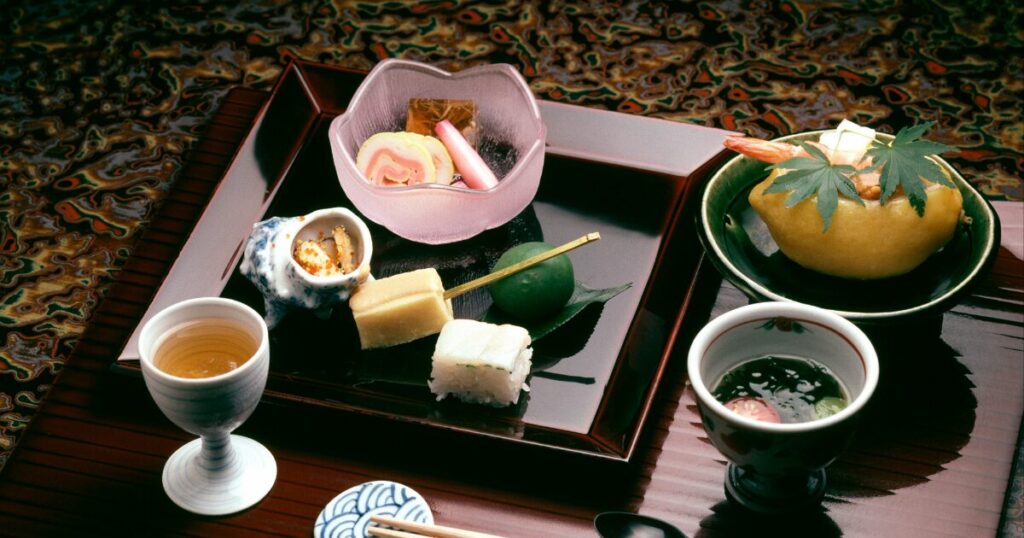
A full formal tea ceremony, or chaji, is the most traditional and immersive way to experience the Way of Tea. It can last three to four hours and usually includes a multi-course kaiseki meal, followed by thick tea (koicha) and thin tea (usucha).
This is ideal for travelers who want to fully embrace the ritual, though it requires more time and often a higher budget.
Short Ceremony (Chakai)
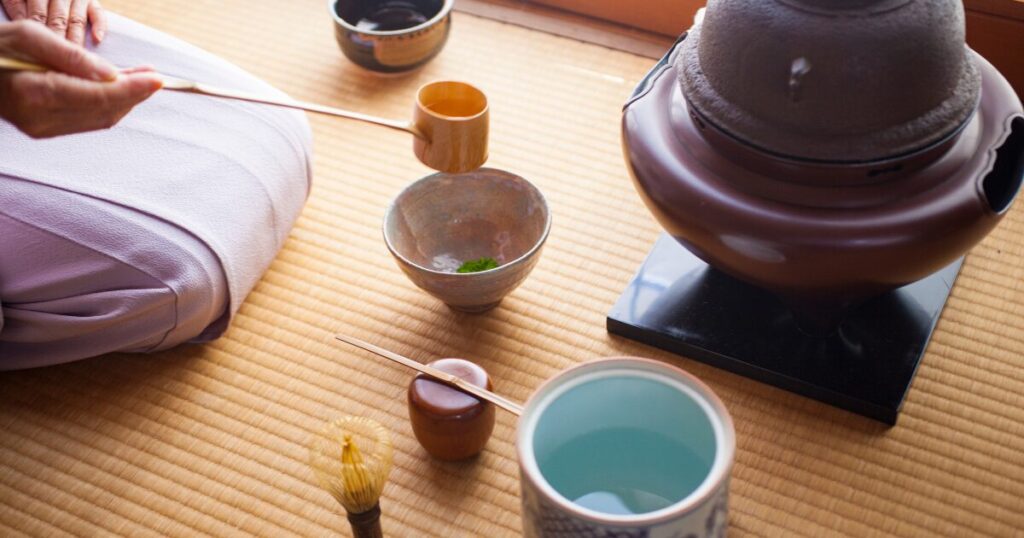
The short ceremony, or chakai, is perfect for visitors who want to enjoy matcha in a condensed format without sacrificing authenticity.
Lasting around 30 to 45 minutes, it typically includes seasonal Japanese sweets and a demonstration of matcha preparation by the host.
It’s a great way to experience the essence of tea culture while leaving room in your itinerary for other activities.
Tea Ceremony + Kimono Rental
For travelers looking to combine cultural immersion with a memorable photo opportunity, many venues offer tea ceremonies paired with kimono rental.
The experience usually begins with dressing in traditional attire before joining a tea session, allowing you to fully feel the atmosphere of historical Japan.
This combination is especially popular in Kyoto, Tokyo, and Kanazawa, where scenic backdrops enhance both the ceremony and your photos.
What Happens During a Tea Ceremony – Step-by-Step
If it’s your first time, here’s what to expect so you can relax and enjoy the moment.
Host explains the ceremony in English.
Some venues have a small water basin for symbolic cleansing.
Host whisks matcha using precise, graceful movements.
Guests bow, turn the cup, and take small sips.
Host shares final greetings and sometimes lets guests try whisking matcha themselves.
Tea Ceremony Experiences in Japan – Where to Go
Japan offers countless tea ceremony venues, from historic temples to modern cultural studios. Here are the best places for travelers.
Kyoto – The Heart of Tea Culture
Kyoto is considered the birthplace of many Japanese tea traditions and remains the most iconic destination for experiencing an authentic tea ceremony.
The city’s historic temples, tea houses, and gardens provide the perfect backdrop for enjoying matcha in a traditional setting.
- Camellia Tea Ceremony
Near Kiyomizu-dera, offers English-guided sessions and hands-on matcha making. - Maikoya Kyoto
Combines tea ceremony with kimono rental for the perfect cultural photo. - Kodaiji Temple Tea House
Historic tea house set in a Zen garden.
Tokyo – Accessible and Diverse Experiences
Tokyo offers a wide range of tea ceremony experiences, from traditional tea houses in serene gardens to modern studios in the heart of the city.
Its accessibility and variety make it easy for travelers to enjoy matcha, no matter their schedule or budget.
- Happo-en (Shirokanedai)
Elegant garden setting with seasonal sweets. - Maikoya Tokyo
Conveniently located in Shinjuku; offers kimono and tea together. - Hotel Chinzanso Tokyo
Luxury tea service in a lush garden.
Other Recommended Locations
Other parts of Japan also offer memorable tea ceremony experiences, often in unique regional settings.
From historic merchant houses to serene gardens, these locations provide a more intimate and sometimes less crowded alternative to major cities like Kyoto and Tokyo.
- Kanazawa – Gyokusen-en Garden
Private tea ceremony in a traditional garden. - Nara – Machiya Townhouses
Experience tea in historic merchant homes. - Hokkaido – Seasonal Cultural Events
Tea ceremonies during cherry blossom or autumn festivals.
Tea ceremony in Japan – Cost and Duration
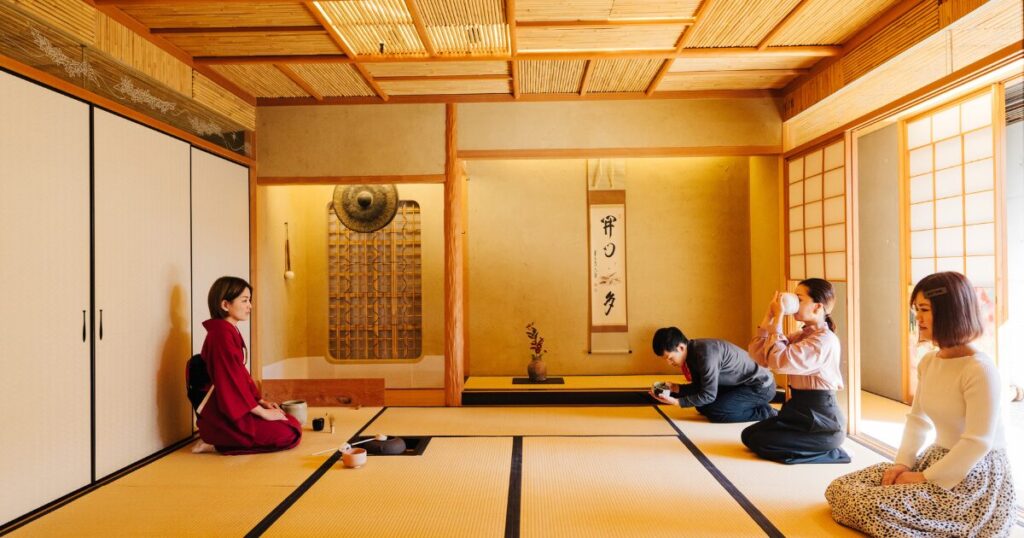
The cost and length of a tea ceremony in Japan vary depending on the style, location, and level of formality. Shorter experiences are perfect for casual visitors, while more elaborate sessions cater to those seeking deeper cultural immersion.
Knowing the average price and time commitment will help you choose the option that fits your travel plans and budget.
| Type of Experience | Average Duration | Price (per person) |
|---|---|---|
| Short Chakai | 30–45 min | ¥2,000–¥4,000 |
| Kimono + Tea | 60–90 min | ¥4,000–¥8,000 |
| Full Chaji | 3–4 hours | ¥15,000–¥30,000 |
How to Book a Tea Ceremony in Japan
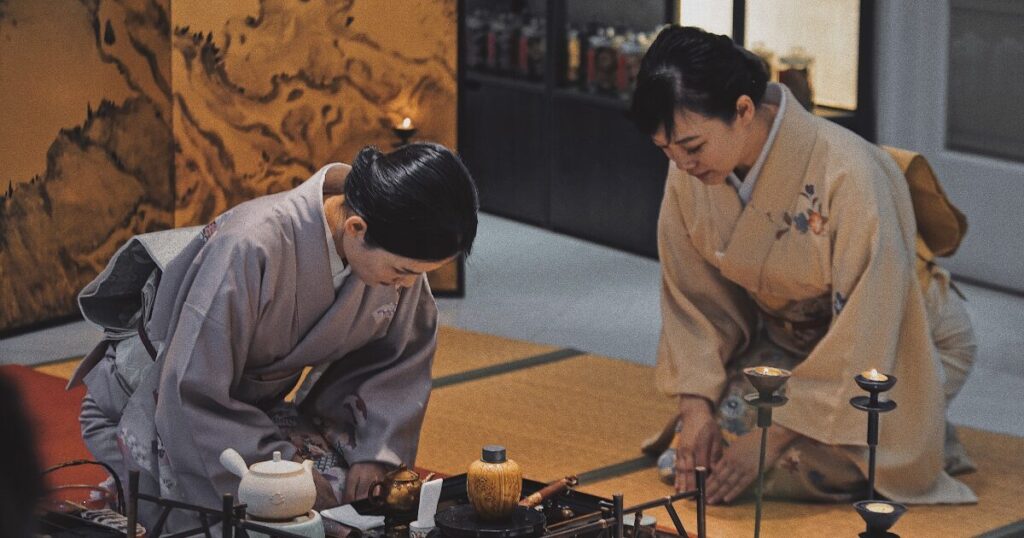
Tea ceremonies are often held in small, intimate spaces, meaning spots can fill up quickly especially during peak travel seasons.
While some venues accept walk-ins, most require reservations to ensure a smooth experience. Here are the most common ways to secure your spot.
Book Online in Advance
Booking online is the most convenient option for travelers who want to plan ahead. Websites like Klook, GetYourGuide, and Maikoya allow you to reserve in English, with instant confirmation and clear cancellation policies.
Book via Hotel Concierge
Many hotels, especially luxury and boutique accommodations, have partnerships with local tea houses. The concierge can arrange your booking, often securing preferred time slots and English-speaking hosts.
Walk-in at Tourist Hotspots
Some popular locations, such as Camellia Tea Ceremony in Kyoto, accept walk-ins outside peak hours. However, availability is not guaranteed, so walk-ins are best for travelers with flexible schedules.
Practical Tips for Your Tea Ceremony Experience
What to Wear to a Tea Ceremony
Choosing the right attire will help you feel comfortable and respectful during the ceremony. While kimonos are optional, modest and neat clothing is always appreciated. Dressing appropriately also makes it easier to sit comfortably on tatami mats for the duration of the event.
- Recommended: Long pants or skirts, covered shoulders, simple colors.
- Avoid: Strong perfumes, noisy accessories, and hats.
Tea ceremony etiquette for tourists
Following basic etiquette ensures a smoother and more enjoyable experience for both you and the host. Even if you’re unfamiliar with the customs, showing attentiveness and respect goes a long way. Here are some simple manners to remember during your visit.
- Bow when greeting the host.
- Handle the tea bowl gently with both hands.
- Eat the provided sweets before drinking tea.
- Avoid speaking loudly or interrupting the host.
- Offer a polite thank-you at the end of the session.
Best Time to Join a Tea Ceremony
Tea ceremonies are held year-round, but the atmosphere changes with the seasons. Seasonal sweets, flower arrangements, and garden views enhance the experience in unique ways.
Spring and autumn are particularly popular due to cherry blossoms and fall foliage, while winter offers a quieter, more intimate ambiance.
| Season | Highlights in Tea Ceremony | Recommended For |
|---|---|---|
| Spring (Mar–May) | Cherry blossoms, pastel seasonal sweets, pleasant weather | Visitors who want a picturesque garden setting and mild climate |
| Summer (Jun–Aug) | Refreshing sweets, cool interior settings, occasional evening ceremonies | Travelers seeking a calmer tea house experience away from crowds |
| Autumn (Sep–Nov) | Red and golden foliage, rich flavors in seasonal sweets, cozy atmosphere | Photography lovers and those who enjoy warm, earthy aesthetics |
| Winter (Dec–Feb) | Quiet atmosphere, fewer tourists, warm matcha in a serene setting | Visitors who want an intimate and peaceful tea ceremony |
Tea ceremony souvenirs and gifts
Bringing home a piece of your tea ceremony experience is a wonderful way to remember your trip. Many venues sell matcha powder, handcrafted tea bowls, bamboo whisks, and decorative tea caddies.
Purchasing directly from the tea house supports local artisans and ensures the quality and authenticity of your souvenir.
FAQ About Tea Ceremony in Japan
- What is the best city in Japan to experience a tea ceremony?
-
Kyoto is the most popular city for tea ceremonies due to its rich cultural history and abundance of traditional tea houses. However, Tokyo, Kanazawa, and Nara also offer excellent experiences that are easier to access for some travelers.
- Do I need to speak Japanese to join a tea ceremony?
-
No, many tea ceremony venues in Japan offer English guidance or have printed explanations. Booking through platforms like Klook or GetYourGuide ensures you can find English-friendly hosts.
- How much does a tea ceremony cost in Japan?
-
Short tea ceremonies start from around ¥2,000 per person, while kimono-inclusive sessions range from ¥4,000 to ¥8,000. Formal, multi-course ceremonies can cost ¥15,000 or more.
- How long does a tea ceremony last?
-
A short tea ceremony (chakai) usually lasts 30–45 minutes, while a full formal ceremony (chaji) can take 3–4 hours. Kimono-inclusive experiences typically last 60–90 minutes.
- What should I wear to a tea ceremony in Japan?
-
Modest and comfortable clothing is recommended. While kimonos are optional, avoid strong perfumes, flashy accessories, and revealing outfits. Shoes will usually be removed before entering the tea room.
- Can children join a tea ceremony?
-
Yes, many venues welcome children, especially for short and casual sessions. However, full formal ceremonies may not be suitable for young children due to their length and quiet atmosphere.
- Do I need to book a tea ceremony in advance?
-
Advance booking is highly recommended, especially during peak travel seasons like spring and autumn. Some popular spots accept walk-ins, but availability is not guaranteed.
Final Tips for Enjoying Your Tea Ceremony in Japan
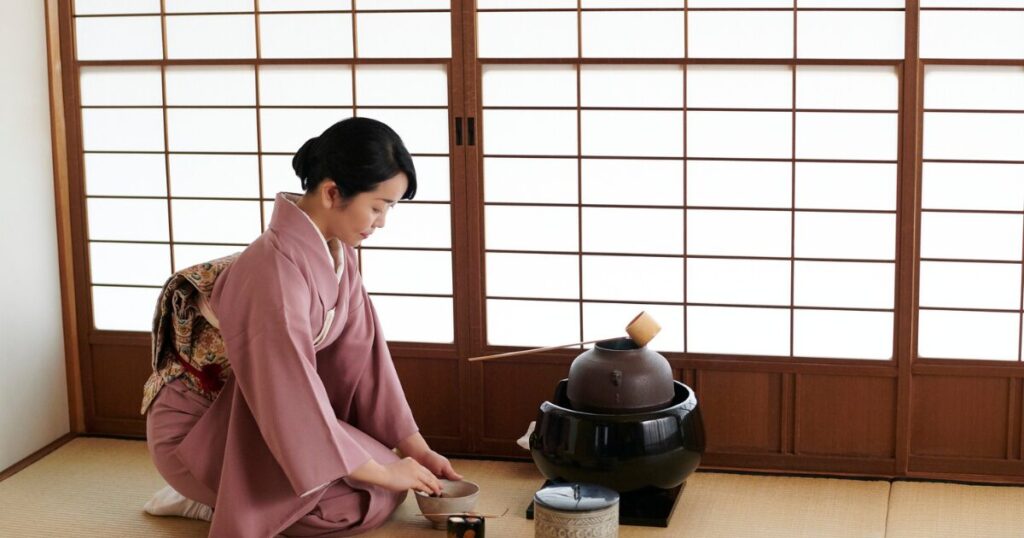
The Japanese tea ceremony is more than just a cup of matcha. It’s a moment to slow down and appreciate hospitality, artistry, and tradition.
Arrive a little early, listen carefully to your host, and allow yourself to be present in the experience. Whether you choose a quick session or a formal gathering, you’ll leave with a deeper appreciation for Japanese culture.

